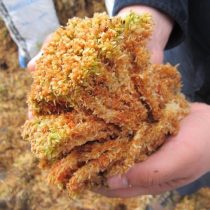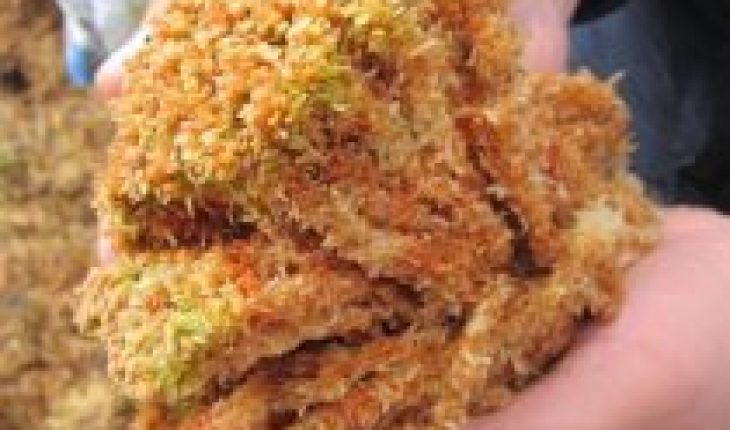
In the Chiloé Archipelago there are no freshwater supplies from the melting of the mountains as on the mainland, but its underground napas feed on rainwater accumulated in a type of wetland called “Peatlands”. It slowly releases these waters to the aquifers where the moss Sphagnum magallanicum, known as “Pompón”, grows, which is able to absorb up to 20 times its weight in water.
But for some years the moss has been extracted unchecked until taking this resource to steps away and so also the fresh water that in summer season decreases more and more in Chiloé.
For this reason, the “Wetlands of Chiloé: Heritage of All”, a public-private body that ensures the importance of conserving these fragile ecosystems, is promoting a number of initiatives for the protection of coastal and terrestrial wetlands.
Its spokesman is Gabriela Navarro, ecologist and in charge of the Scientific Extension Unit of the Puerto Montt Headquarters of the U. Austral of Chile, and currently convenes ideas, media and people in search of solutions for the care of the wetlands of Chiloé, such as the inventory made by the University through a Corfo project and the implementation of a Wetland Interpretation Center in the Locality of Yaldad , commune of Quellón.
But none of this is sufficient, if it is not supplemented by adequate regulation in the extraction of the so-called Sphagnum magallanicum. Navarro points out that in Chiloé there are very special conditions because it is a territory that in addition to being geographically isolated every year suffers important drought problems during the summer season.
“Due to the water crisis affecting the planet that is the product of climate change, which in the archipelago is exacerbated, because we do not have snow-capped mountain ranges as solid freshwater reserves. That’s why extensive exploration of Sphagnum moss has a direct impact on people as it is a unique ecosystem that protects and nourishes the aquifers that provide fresh water on which the entire population of Chiloé depends,” he says.
The commercial use of the Pompom
Sphagnum or pom pom is used worldwide in nurseries and gardening, as well as as a thermal insulator, as an organic floor, filters, among others. Thus, over the last 20 years, there has been a great demand and progressive interest in the exploitation of this resource that is harvested by farmers from the Los Lagos region for marketing as a substrate in horticultural, fruit or orchid crops, for the absorbent products industry.
The extraction of living moss and its exploitation have initiated a worrying exploitation of these ecosystems, especially in the Chiloé Archipelago, which is reflected in the sustained increase in the degradation of these wetlands, with a significant level of site involvement. With the lack of regulation in the extraction, drying, packaging and transport techniques, which should be associated with a regulation, is the path that could stop the irreversible impact on the availability of fresh water for the Chiloé archipelago.
Law prohibiting its extraction
While there are a variety of studies that have been carried out on the possibility of sustainable management in the extraction and production of the Pom-Pom, it is still insufficient to ensure that these ecosystems maintain vital characteristics and functions.
The Chiloé Bureau of Wetlands sees with concern that our country does not have legal protection for this moss, as a plant species of slow growth and very important for the water regulation of territories such as the Chiloé archipelago, which could be legally protected urgently, as are other emblematic plant species of Chileans.
Navarro explains that “there are some legal instruments that have been to be implemented for some time in our country, such as Decree No. 25 of the Ministry of Agriculture that sent the SAG to regulate, monitor and catarify this productive activity, or the draft Law on Environmental Protection of Peatlands that still sleep in parliament. But that they do not appear to be effective either, because in my opinion, in the province of Chiloé a regulation prohibiting the extraction of this particular important species, the Moss Sphagnum magallanicum or “Pompón”, should be protected by law just as are other emblematic species such as the Alerce and the Araucaria”.
The Chiloé Wetlands table is co-by the following institutions: Seremi of the Environment, Provincial Governorate of Chiloé, Maritime Governorate of Chiloé, Conaf, Sernageomin Technical Office, Municipality of Castro, Municipality of Curaco De Vélez, Municipality of Quinchao, Municipality of Queilen, Municipality of Quellón, Municipality of Ancud, in others, Institute of Fisheries Development (IFOP), Association for the Defense of the Environment and the Culture of Chiloé (ADAC), , Universidad Austral de Chile Headquarters Puerto Montt, NGO Conservación Marina and Representatives of other private sector institutions.





